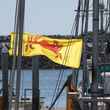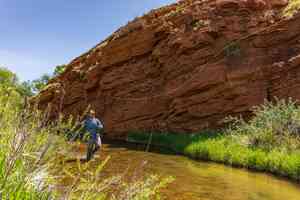As we sat around what was left of the cooking fire on a bluff overlooking the stunning Aishihik Lake, happily sated by a robust New York strip that, minutes earlier, sizzled and snapped on the grill hung low over the coals, it was time to talk fish. Earlier that day, with our guide Allan Hansen, we’d motored around the lake and caught a good number of lake trout and northern pike. The lakers interested me the most. Some were short and big around. Others were behemoths. Still others were smaller and more sleek, and their colors were vibrant.
“They’re all different strains of lake trout,” Allan said. “They swim in different parts of the lake. Some are ‘cold-water fish’ that stay deep all year long. Some move into the shallows in the spring and fall.” Some, he said, even spawn in the rivers. There’s even lake trout “strain,” Allan said, that sports a giant head and a very small body — he and his fellow guides out of Dalton Trail Lodge have only caught a few of these specimens over the years.
It wasn’t a new concept for me, the idea that fish of the same general species might break into different behavioral strains. But it was the first time I’d seen this up close and personal.
After years of armchair fisheries biology, I’ve learned a few things from the salmonid world. What we were likely witnessing in the lake is what fisheries biologists call the “portfolio effect” — nature’s way of combating natural calamities that might take out an entire fish population if all of its members behaved the same way all the time.
It’s likely best described in salmon, where biologists have long understood that some salmon leave the ocean in late summer, some in the winter and some even in late spring — all with the intent of reproducing. Should one population fall victim to some devastating event — a landslide that blocks the migration, a toxic chemical spill or superheated water, for instance — another run will arrive later, ensuring the survival of the species as a whole.
I outlined that logic to Allan, and he nodded along, and noted that it makes perfect sense. Genetically, it’s likely that all the fish in Aishihik Lake are basically the same. For whatever reason, though, some fish simply behave differently than others. The same logic could be applied to rainbow trout and steelhead. Some strike out for the ocean. Others choose to say home. Genetically, they’re virtually identical.
Wild? Native? Both?
“Our native rainbows don’t seem to do that,” Allan said. “They’re pretty much all the same. They’re bright and shiny all the time.”
I shook my head from across the fire. It’s a trap that a lot of anglers fall into, and not just in the wilds of the Canadian north. I can’t count the times I’ve had to correct anglers here in my home water when they tell me they spent a great day catching “native brook trout” high in the mountains of eastern Idaho. There are, of course, no native brook trout in Idaho. Wild? Certainly. But not native.
“Ahem,” I coughed. “Well, that might be because there are no native rainbow trout in the Yukon. They were all introduced in the 1950s.”
Allan perked up, and his body language changed. A confused look crossed his face.
“I could argue?” he half questioned, and half challenged.
“Go right ahead,” I said confidently. And I explained that the rainbows found in the Yukon were brought in about 75 years ago and planted in southern Yukon streams for sporting purposes. The native salmonids of the region are lake trout, some relict populations of Dolly Varden, perhaps some bull trout along the southern border with British Columba, lake whitefish and, of course, Arctic grayling.
“Huh,” he said, clearly in head-scratching mode. “They’ve been in the Kathleen River for as long as I can remember.”
Happily losing an argument
A week later, home in Idaho and busy catching up after a great trip to the Yukon, my phone rang. The caller was Robert Perry, a “species officer” with the Yukon Department of Environment. He’d read a sample itinerary on the website of a travel company I’m affiliated with, and wanted to help me correct some bad information.
“I was told you were the person I need to talk to about correcting some information on a web page,” Perry said. I agreed, and if there was indeed some bad intel, I’d be more than happy to correct the error, I explained.
“Well, I just need to make clear that there are native rainbow trout in the Yukon,” Perry said.

As it turns out, the Tatshenshini and Alsek rivers both flow from the mountains of the Yukon south into British Columbia. Both rivers slice through the glacial ice fields along the B.C. and Alaska border and then drain into Dry Bay at the north end of Glacier Bay National Park. And both rivers are home to rainbow trout. Or, for the sticklers out there, steelhead that opted to stay home.
(Side note: The Tatshenshini River is still home to the southern Yukon’s only salmon runs. Both sockeye and coho salmon make the run up the river from the Pacific — but not in the great numbers from years past.)
And the Kathleen River? It’s a tributary to the Alsek via the Dezadeash River. It’s one of the few rivers in the Yukon that has a connection to the Pacific, albeit a tenuous one, given Ice Age geology and all that. Today, the Alsek runs from the Yukon, into British Columbia and skirts the edges of the largest non-polar ice field on the planet before it dumps into the ocean. The Alsek contributes the fifth-largest discharge of water on the west coasts of the Americas. By any measure, it’s one of the world’s great rivers.
There were, indeed, rainbow trout introduced to the Yukon — they were planted in a few streams near Whitehorse for recreation and as a source of food for the locals. They persist today, and are, today, wild. But those fish are not native.
But the rainbows in the Kathleen River are native trout, Perry explained to me. And they've been in the Kathleen for eons. And, what’s more, I learned, the fish have been isolated so long from the bulk of the Alsek system that they are genetically unique. They are found nowhere else in the world but in the Kathleen River.
Allan, I tip my hat to you. You were right.
Would that I have known
Two days earlier, I stood hip-deep in the icy flows of the lower Kathleen River where it widens into slow-moving Rainbow Lake. A glance at the wallpaper was stunning. Mt. Martha and Mt. Kathleen loomed large over the valley, and the verdant burst of spring green was at its peak. The water, crystal clear, flowed slowly around my legs as I cast a small streamer and let it swing.
It didn’t take long for the line to stretch tight, and the rainbow on the other end blasted out of the water and cartwheeled a couple of times to put on a show. It was a nice fish — one of maybe two rainbows we brought to hand that hit the 16-inch mark.
At the time, I was pleased with the catch, but I was also a realist. I’d traveled thousands of miles to the Yukon and here I was catching middle-sized rainbows introduced to the area 75 years ago by an Anglo-run government agency to “improve” the local fishery. Blah, blah, blah.
Had I known at the time that these rainbows were native fish, and not the wild offspring of hatchery reared trout, I would have been much more appreciative. Catching trout is one thing. Catching trout where they belong? That’s something else altogether.
The Kathleen River system is one of the most stunning waters I’ve ever fished. Under bright, blue late-spring skies, it was easy to see how Rainbow Lake got its name. Its waters range from deep blue and Caribbean green to a unique shade of turquoise that absolutely glimmers under the sub-Arctic sun (to say nothing of the native trout that swim in its waters). Straight and tall spruce trees guard the banks and the craggy, high peaks to the west are just one mountain range away from the ocean. Their snow-laden tops gave way to alpine splendor. It’s a viewscape I’d put up against the Tetons, the Sawtooths or even the vertical cliffs of the Alps and the Andes. It was stunning.
Fishing was good, but not great. The wind picked up, which made fishing the lake sections tough, but we managed to pull in a handful of nice rainbows, a few Arctic grayling and one seemingly lost 18-inch lake trout. I learned later, though, that the lakers are also a part of the Kathleen’s fishy tapestry, as are kokanee salmon in the system’s upper reaches and whitefish, which can show up almost anywhere.
Oddly, now that I know the chrome-bright rainbows with glorious rosé cheeks were native, I think more fondly about that day on the river. Before I knew, I was more or less agnostic about it.
In the Yukon, the natural order of things is still largely intact. And, I thought, the rainbows represented a scar that won’t ever fully heal — and we see those scars here in the Lower 48 every day where, over time, we’ve whimsically and willingly altered our environment.
Knowing now that the Kathleen's rainbows are exactly where they belong? Well, that’s perfection, no matter how good the fishing is.






























Comments